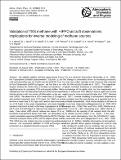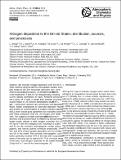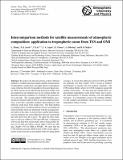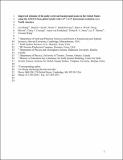Search
Now showing items 1-10 of 60
Isoprene Emissions in Africa Inferred from OMI Observations of Formaldehyde Columns
(European Geosciences Union, 2012)
We use 2005–2009 satellite observations of formaldehyde (HCHO) columns from the OMI instrument to infer biogenic isoprene emissions at monthly 1 × 1° resolution over the African continent. Our work includes new approaches ...
Validation of TES Methane with HIPPO Aircraft Observations: Implications for Inverse Modeling of Methane Sources
(Copernicus GmbH, 2012)
We validate satellite methane observations from the Tropospheric Emission Spectrometer (TES) with 151 aircraft vertical profiles over the Pacific from the HIAPER Pole-to-Pole Observation (HIPPO) program. We find that a ...
Gas-Particle Partitioning of Atmospheric Hg(II) and Its Effect on Global Mercury Deposition
(Copernicus GmbH, 2012)
Atmospheric deposition of Hg(II) represents a major input of mercury to surface environments. The phase of Hg(II) (gas or particle) has important implications for deposition. We use long-term observations of reactive gaseous ...
Nitrogen Deposition to the United States: Distribution, Sources, and Processes
(European Geosciences Union, 2012)
We simulate nitrogen deposition over the US in 2006–2008 by using the GEOS-Chem global chemical transport model at 1/2°×2/3° horizontal resolution over North America and adjacent oceans. US emissions of NOx and NH3 in the ...
Riverine source of Arctic Ocean mercury inferred from atmospheric observations
(Springer Nature, 2012)
Methylmercury is a potent neurotoxin that accumulates in aquatic food webs. Human activities, including industry and mining, have increased inorganic mercury inputs to terrestrial and aquatic ecosystems. Methylation of ...
The United States' Next Generation of Atmospheric Composition and Coastal Ecosystem Measurements: NASA's Geostationary Coastal and Air Pollution Events (GEO-CAPE) Mission
(American Meteorological Society, 2012)
The Geostationary Coastal and Air Pollution Events (GEO-CAPE) mission was recommended by the National Research Council's (NRC's) Earth Science Decadal Survey to measure tropospheric trace gases and aerosols and coastal ...
Correlations between Fine Particulate Matter \((PM_{2.5})\) and Meteorological Variables in the United States: Implications for the Sensitivity of \(PM_{2.5}\) to Climate Change
(Elsevier, 2010)
We applied a multiple linear regression (MLR) model to study the correlations of total \(PM_{2.5}\) and its components with meteorological variables using an 11-year (1998–2008) observational record over the contiguous US. ...
Chemistry of Hydrogen Oxide Radicals \((HO_x)\) in the Arctic Troposphere in Spring
(European Geosciences Union, 2010)
We use observations from the April 2008 NASA ARCTAS aircraft campaign to the North American Arctic, interpreted with a global 3-D chemical transport model (GEOS-Chem), to better understand the sources and cycling of hydrogen ...
Intercomparison Methods for Satellite Measurements of Atmospheric Composition: Application to Tropospheric Ozone from TES and OMI
(European Geosciences Union, 2010)
We analyze the theoretical basis of three different methods to validate and intercompare satellite measurements of atmospheric composition, and apply them to tropospheric ozone retrievals from the Tropospheric Emission ...
Improved estimate of the policy-relevant background ozone in the United States using the GEOS-Chem global model with 1/2° × 2/3° horizontal resolution over North America
(Elsevier BV, 2011)
The policy-relevant background (PRB) ozone is defined by the US Environmental Protection Agency (EPA) as the surface ozone concentration that would be present over the US in the absence of North American anthropogenic ...









